Want even more customization? You can add tape flags, rulers, pockets (and combined pocket dividers) to create your ideal notebook.
LEVENGER CIRCA
Early on, the best known variety of disc-bound notebooks was the Circa line from Levenger. Circa doesn’t just have a system, it has a whole eco-system, with discs as small as 1/4″ that can hold up to 50 sheets of paper to 3″ discs that can hold up to 450 sheets. (Obviously, once you get that large, you’re giving up the size advantages of disc-bound over ring-bound notebooks.)
To start, you can pick from two notebook cover types: leather covers or leather “alternative” covers.
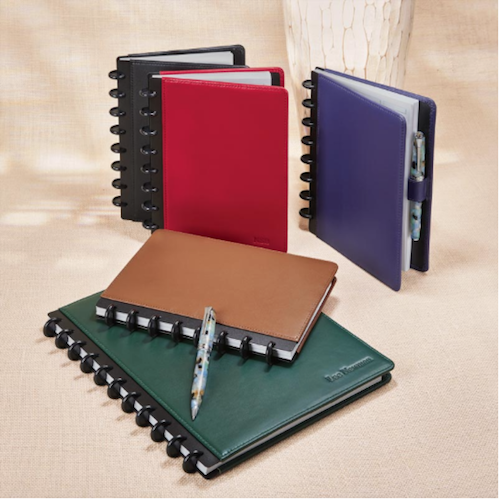
The full-grain, pebbled leather covers come a variety of styles. For example, the Circa Leather Foldover Notebooks are available in black, purple, red, saddle (brown) and pine (green) in two sizes, Junior (7″ wide x 8 5/8″ high) with 8 discs, and Letter (9 3/4″ wide x 11 3/8″ high) with 11 discs, both designed with 3/4″ discs to accommodate up to 120 sheets of paper; however, the notebook comes with only 60 sheets of 90-gsm ruled paper. A similar option is the Carrie Foldover, in the same size but in British Tan, Blush, or Classic Blue, and there are more upscale padfolio, portfolio, and planner folio styles.
The notebooks have black twill lining and pockets for business cards, index cards, and loose pages, and an elastic pen loop.
For those who prefer a tiny notebook, there’s the Circa Jotlet, which comes with leather covers in the same colors as the Circa Leather Foldover Notebooks (with black leather lining), but measure only 3″ wide x 5″ high and comes with 30 notecards (250-gsm paper), ruled on both sides, with 1/2″ black discs and a sturdy leather cover.
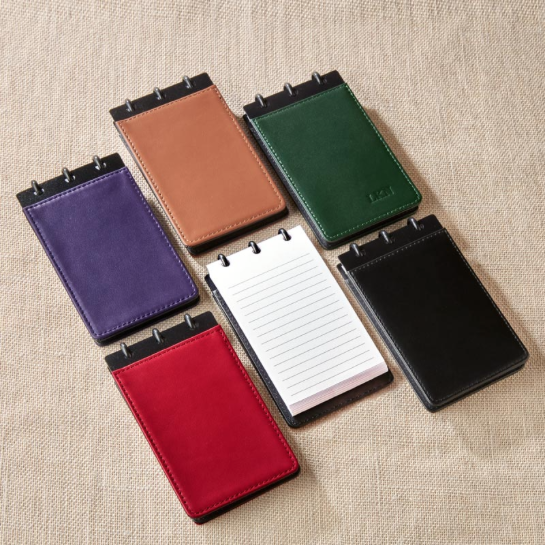
Like cows too much to go for leather? The Circa Leather Alternative Notebooks come in a wide variety of styles and covers similar to the leather versions. The Lev-Tex (leather-like) covers come in black, French blue, purple, red, and hickory (a dark brown), and the Junior size is an inch narrower at 6 1/2″ wide x 8 5/8″ high. There are also a variety of patterned covers.
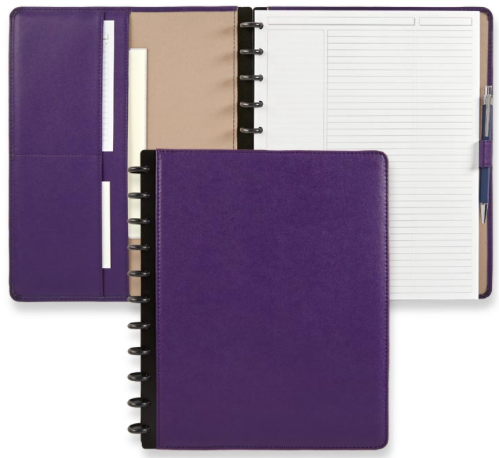 Next, once you’ve got your cover picked out, you can customize to your heart’s delight.
Next, once you’ve got your cover picked out, you can customize to your heart’s delight.
Let’s talk discs. If you’ve seen notebook discs before, they’ve probably been black, white, or clear plastic, or perhaps a shiny metal, but Levenger’s Circa line of discs goes beyond that to true fashion-forward customization, like their shiny Aluminum linen of discs in rose gold, oxblood, berry, cobalt blue, copper, gold, platinum, silver, and ultra-violet:
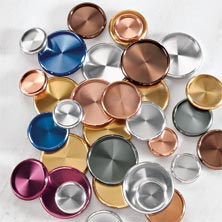
and colorful plastic Prima and Chromatic discs:
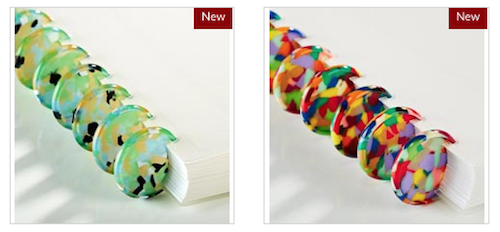
The more fashionable discs come in sets of 11; the more quotidian plastic versions in sets of 22. Pricing generally ranges from $20 to $35, but Levenger often has sales on different sets.
If ruled paper isn’t your jam, you can separately purchase any of 70 different page refills, including rainbow-hughed lined/ruled paper, Jotlet message card and project planner refills, address book page refills, blank paper, college ruled, and more:
- Annotation Ruled refills (300/pack) in Junior and Letter sizes
- Engineer Grid refills (100/pack) in Letter size – 1/8″ grid (8 squares per inch, 64 squares per square inch)
- Things To Do refills (100/pack) in Junior, Letter, and Compact sizes
- Multitask Organizer refills (100/pack) in Junior – This format is what we might consider weekly planner or agenda format.
- Shopping List refills (100/pack) in Junior – with excruciatingly granular grocery options listed.
- Storyboard refills (100/pack) in Letter – with three boxes for diagrams, drawings or key points, and 10 lines for notes per box.
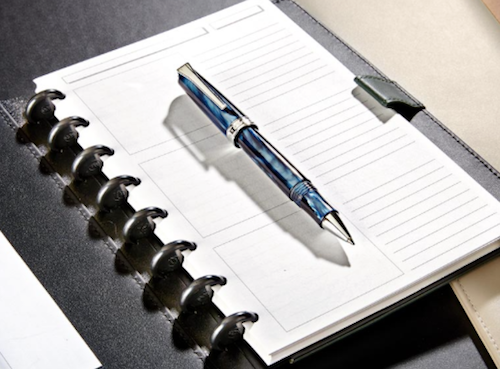
Refill packs for 100/pack items vary in price by style and size but are generally between $10 and $25; items in greater bulk (like 300/pack) can be $35+.
Oh, but you say you want to customize more than just your covers, discs, and paper? You want goodies, too? How about accessories for the inside and outside of your notebooks, like zipper pockets, sheet protectors, business card holders, checklist pads, and more:
- Notebook belts to keep your papers private (and hold a pen) in gold and silver
- Reinforcement strips to protect the punched edges of your most-used, most-often moved pages
- Vivacious plastic covers in turquoise, yellow, orange and green for spotting your notebook quickly and keeping it protected under rough-and-tumble circumstances. There are also Vivacious plastic tab and pocket dividers.
- Tab dividers for top or side use, and annotation tabs, so you can sort your notebook however you’d like!
And, of course, Levenger has Circa punches so you can customize any fairly-flat, paper-ish thing you want to put in your notebook.
As you can imagine, Levenger’s Circa line wasn’t (and isn’t) just the fanciest of customizable disc-based notebooks, but the most expensive. A Circa could run you $55-109 for a notebook, plus up to and beyond $100 more for customization. Whew.
ARC
On the plus side for those of us who are a little (or a lot) more budget conscious, there have been a lot of copycats of the Circa line. Well, they do say that imitation is the sincerest form of flattery. The first to flatter Circa was Arc by Staples (also called M by Staples Arc Customizable Notebooks).
With Arc, you have fewer options, but you also won’t break the bank. Start with what they call “pre-assembled notebooks.
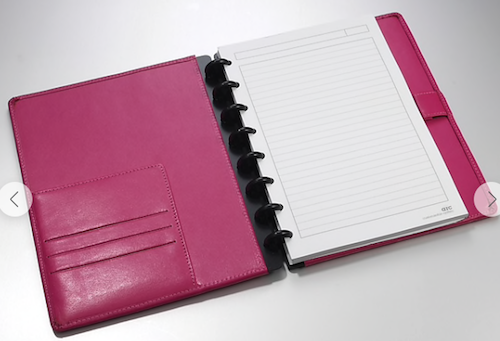
Arc leather covers come in three sizes/styles:
- Junior: 6 3/4″ wide x 8 3/4″ high in black, blue, or pink, with 8 black plastic discs, for $17.29
- Standard: 9 1/2″ wide x 11 1/2″ high in black, brown, burgundy, or purple, with 11 black plastic discs, for $26.99
- Top-Bound: 8 1/2″ wide x 11″ in black, with 8 black plastic discs along the top instead of the left side, for $29.49 (This version has been discontinued, but you can still find it in a few places.)
All three come with 3/4″ discs, 60 narrow-ruled sheets of paper, and a pen-holder.
If you want to fancy-up and go for a stand-alone cover, there are occasionally limited-edition designer alternatives. In addition, there’s a small line of Martha Stewart-branded Arc notebook covers that run from $15-$26. However, I’m somewhat hesitant to recommend them, as I’ve had a number of purchases of Martha’s products (especially label makers) turn out to be duds over the years. Caveat emptor.
You won’t find any fancy discs with Arc; they’re all black. Want a fatter notebook? A 12-pack of 1″ expansion discs will set you back $4.79. For 1 1/2″ discs, it’s $4.99.
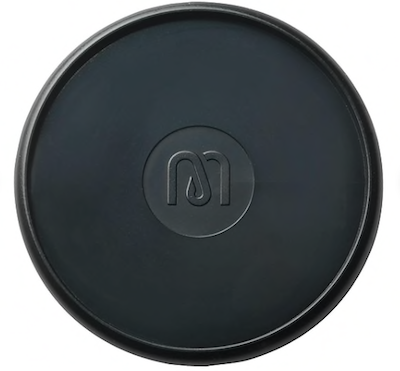
Your Arc paper choices are narrower than with Levenger, too. You can have standard narrow-ruled paper, college-ruled Cornell-style annotation pages (the kind with a section to the left for marking key points), graph-ruled, to-do, and project page refills, all in 5 1/2″ x 8 1/2″ or 8 1/2″ x by 11″. For the top-bound notebooks, the only options are white or canary-yellow 8 1/2″ x by 11″ pages. Page refill packs range from $7.50 to $14.
Accessories include a variety of plastic, tabbed index page dividers in black and multi-colors, sheet protectors, pocket dividers, and stickers.
So, less pricey, but less inspired.
BUT GUESS WHAT? Staple’s Arc covers, discs, papers, and most accessories are interchangeable with Levenger’s Circa items. Per the much-missed Office Supply Geek blogger (who has been AWOL a few years), the only differences are that, “The Staples version of the pages are about 1/64″ wider but it does not impact their functionality at all. The mushroom shaped punch outs used to bind the paper to the discs are also different sizes on both brands. The stem of the mushroom appears to be the same size on each but the dome of the mushroom is larger and wider on the Levenger paper.”
So, you can mix and match, going for lower-cost covers and a higher-priced set of discs, or just augment your basic Arc system with the wide variety of refill options at Levenger.
TUL
You didn’t think one Big Box office supply store was going to let the other get a leg up, did you? In between the high-end Circa and the stripped-down Arc, there’s TUL, with a name that sounds like it should be sold at IKEA rather than Office Depot.
Tul notebooks are, like Arc, compatible and interchangeable with Circa (and, obviously, with Arc).
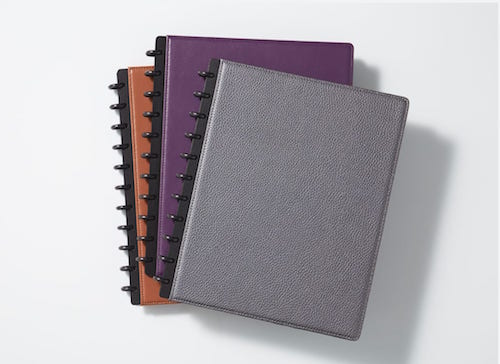
To build your TUL, you start with with selecting your preferred cover in one of three notebook styles: Junior (5 1/2″ wide by 8 1/2″ high, with 8 discs), Letter (8 1/2″ wide x 11″ high, with 11 discs), and Top-Bound (8 1/2″ wide x 11″ high, with 8 discs).
The Top-Bound notebook only comes with a black leather cover and runs about $28. There are a variety of covers for both the Junior and Letter sizes, including pebbled leather (rose gold and gunmetal) and smooth leather (purple, grey, brown, and black) with black discs. There’s also a navy blue leather version with gold foil polka dots in the Junior size! The cost of the leather versions vary by size and style but are priced between $20 and $38.
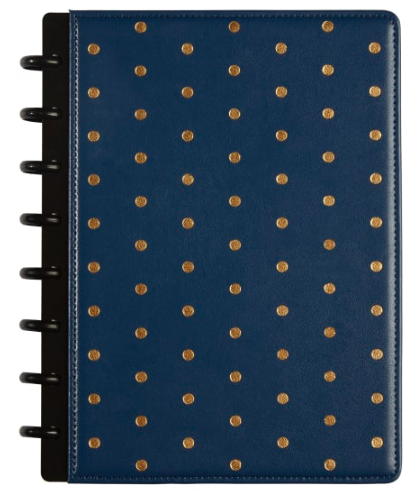
For non-leather options in the Junior size, there are polyurethane covers (pink, teal, and black) with color-coordinated discs for $16.39. In Letter size, TUL offers black and navy “soft-touch” poly covers with color-coordinated disks for $20.39.
Paper options are fairly limited: narrow-ruled (in white and assorted colors), graph, to-do lists, and undated appointment and planning pages. Generally, refills come in packs of 100 pages (50 sheets) or 600 pages (300 sheets) and prices range from $5 to $30.
Accessories are similar to those available for Arc: color and white tab dividers, pocket dividers, and insert-sheets of tape flags and task sheets, as well as a page of pads of lined sticky notes. A package of one dozen black, plastic expansion discs in 1″, 1.5″, and 2″ dimensions run $4-$4.59; they also come in a variety of fashion colors, including rose gold, pink, marble, clear, and gold, for about $7.
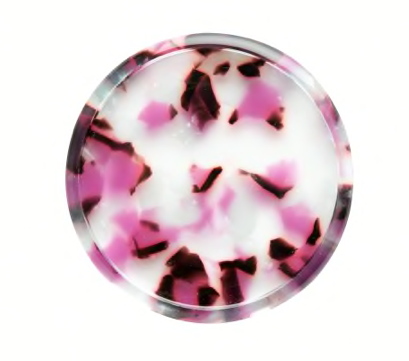
ELEVEN DISCS
Do you like the idea of developing your own disc-based notebook, perhaps with a mix of high-end and more moderately-priced elements? Eleven Discs is a Worthington, Ohio-based family-run business that specializes in disc-based products, including two kinds of notebooks:
Poly Cover Notebooks: The 1 mm-thick poly covers come in mint, pink, purple, black, and translucent in both Junior and Letter. Junior notebooks come with 50 dot-grid sheets and 8 of the 3/4″ discs; Letter notebooks have 40 margin-ruled sheets and 11 of the 3/4″ discs. Priced from $19+.
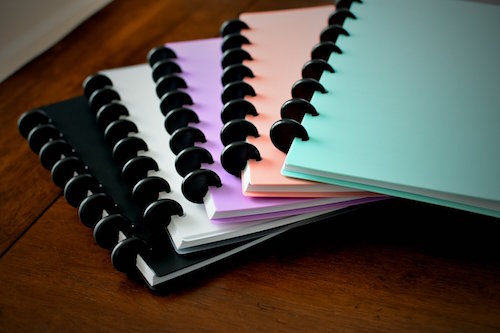
They also sell Brushed Poly Cover Notebooks in orange, light blue, green, grey, and black, but other than the texture, the details are the same as above.
In terms of paper, Eleven Discs offers:
Junior sheets: blank, 3 versions of dot-grid, margin-ruled, ruled, to-do lists, project planning forms, expense logs, mileage logs, daily agenda sheets, square grid sheets, engineering grid sheets, and weekly planner sheets.
Letter sheets: blank, 3 versions of dot-grid, margin-ruled, ruled, square grid sheets, engineering grid sheets, to-do lists, project planning forms, daily agenda sheets, and ledger sheets.
Both sizes run $15 for a pack of 40 double-sided sheets.
Tab Dividers: Eleven Discs has monthly tabs for Junior ($12) and Letter ($13) sizes, as well as packs of five poly, semi-translucent tab dividers with label stickers in Junior and Letter sizes for $8.
Expansion Discs: Packs of 11 aluminum discs come in 3/4″, 1″, and 1 1/2″ sizes, in silver, gold, champaign gold, black, and tungsten for $23+. Plastic discs come in packs of 22 in the same sizes plus 1/2″, in black and translucent, for $9.
When I set out to write this part of the series, I’d anticipated only one post on customizable notebooks, mostly intriguing new-on-the-horizon items I’d found, but in researching old topics, I learned that two of the most popular Paper Doll posts over the years were on modular, disc-based notebooks, so I’m hoping this post has given you some ideas of what you can do to make a notebook truly your own.
Next time, we’ll continue with more customizable notebook options, including a new Rocketbook product with magnetic, swappable pages; a notebook you can have made-to-order with page options that reflect who you are (coffee fiend? pop culture fanatic? chef? business leader?); a landscape-orientation customizable notebook; and more!
Have you missed part of the series? Never fear, the posts are always here:
Noteworthy Notebooks (Part 1): Re-Surveying the Landscape
Noteworthy Notebooks (Part 2): The Big Names in Erasable Notebooks
Noteworthy Notebooks (Part 3): More Erasable & Reusable Notebooks

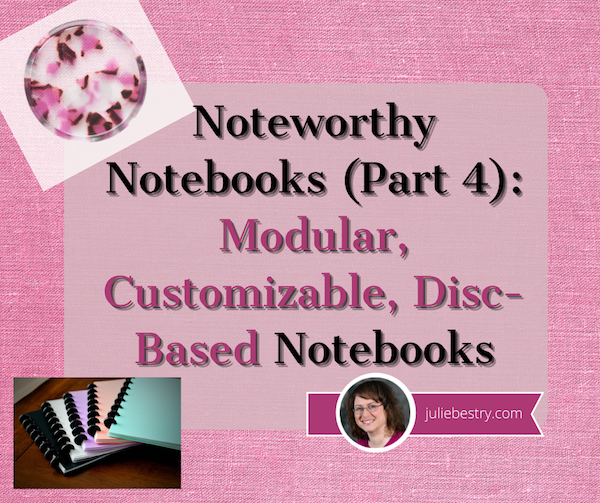



 Next, once you’ve got your cover picked out, you can customize to your heart’s delight.
Next, once you’ve got your cover picked out, you can customize to your heart’s delight.












As always, I’m blown away by the thoroughness of your research! I had a Circa Balanced Life Planner a while back, but didn’t clue into the fact that there were other products in the Circa line! Either that or I pushed them out of mind after seeing the prices.
I typically use a coil notebook for jotting down notes during client calls, and keep an index so I can easily find them when I need to, but being able to put the pages into sections by client is very appealing. I’ll keep it in mind.
Thanks, Janet. I do love to research. This one almost felt too “basic” when I started it; it was just going to be an “also-ran” at the start of a post that will now appear next week. I’m a huge believer that customizing a system to your preferences is necessary for sticking to something. To commit to a notebook, it has to work in your life, and having exactly what you need, where you need it, makes that process easier. And, of course, affordability helps!
Beneficial information. I’m definitely going to share. I love the disc-based notebooks. I use the junior size but have used the larger ones as well.
I wish the “Junior” versions of these notebooks were called something else, Sabrina. Classic or Compact, maybe? Because that is such a reasonable size for so many of our notetaking and creative endeavors. I was dubious of disc-based notebooks when I first learned of them, probably when I saw the Ampad Versa notebook, but when I saw the flexibility and customizability in action, I knew there was a place for it in organized writing!
I am such a paper person, that these are my favorite so far in this series. I see a big benefit to being able to fold it back on itself to take up minimal space, and I love that you have so much writing space.
The “mix and match” features make it fun, like the creativity of a bullet journal.
I might suggest this as a birthday gift. I have NEVER seen the variety of discs outside of this post, so very cool!
I’m glad you liked this, Seana. I really like how Circa, TUL, and Eleven Disc have created more appealing discs for a wider opportunity for customization. I can definitely see giving someone a gift of some of these in their signature colors!
Dot grid paper with the disc-style notebook? SOLD! Thank you for finding this for me, Julie.
Mix-and-match, baby! Dot grid is fun, but I really like that so many of these offer annotation page so I can use them for the Cornell Notetaking System (which, funnily enough, I actually learned at Cornell). And I like how Eleven Discs offers three different types of dot-grid!
A couple of my clients mortgaged their houses to buy Levenger’s Circa products. Anything for organization, right? Seriously, though, I love the customizability.
If only they had known they could mix-and-match, they’d have that summer cottage by now! Customize!
I’m a big fan of the customizable notebooks. I use the Tul notebook and love that the cover folds behind itself. That saves space and makes it easy to take notes on the fly. I didn’t know that the Circa pages by Levenger will work with the Tul notebooks. Hmmm that’s something to think about!
Oooh, you’re the first Tul user I’ve encountered, Diane. I’ll have to see yours once we’re back to in-person gatherings. I really like the fold-behind aspect, too. But I’m just always happy any time we can customize our own things!
Being able to customize is so fun and often key to making the most of your written thoughts. I’m definitely a paper planner. I admit this fully now after trying to go digital. It’s just not the same and I don’t retain the information nearly as well – not even close. The disc expansion rings are something I never would’ve thought of. This is serious business!
Actually, research shows that we learn and remember more when we hand-write things. Digital is good for transcribing information; analog for learning and understanding, because we have to analyze and paraphrase. But there’s room for both for different tasks. I use analog to brainstorm but digital to create (because I type fast but think faster…in long narratives).
I’ve used disc notebooks in the past and liked them, but have focused more on going paperless, so I’m leaning more towards the reusable notebooks in your recent posts. Thanks for the very thorough review.
Thanks, Janet. And there’s even more to come…more analog, more digital, more hybrid! 😉
Fabulous article with tons of in-depth research. Yowza!
I about did a handspring when I noticed the word quotidian used. That’s a high dollar word and one I don’t see too often. Well done, Jules.
Sigh. Now I want to buy some fresh discs.
And when I wrote “fashion-forward,” Geralin, I was thinking of you. I love the flowery pink TUL disc (“Marble”) shown above, but those aluminum ones from Eleven Discs are really snazzy! Be sure to tweet your next purchase and tag me.
Many more intriguing (and not so quotidian) modular notebooks are on their way! I’ll try to use more SAT vocabulary words. 🙂
Julie- You are the researcher extraordinaire!!!! OK. While I’m not in the market for a disc-style notebook, I have to say that the purple one from Levenger’s looks like it has my name on it! Seriously. I’m a big fan of all Levenger products. I used their lined pad regularly. I haven’t ventured into the realm of disc notebooks, but several of my clients have experimented with them over the years with some success. But mostly, they’ve been abandoned as too cumbersome. Perhaps they were keeping too many pages and needed to do some culling.
If I were going to purchase one, I would definitely get one from Levenger’s. They never disappoint.